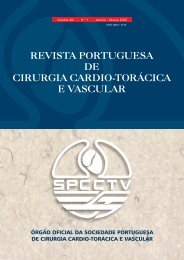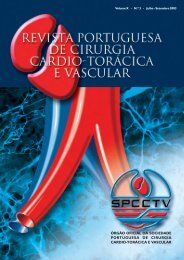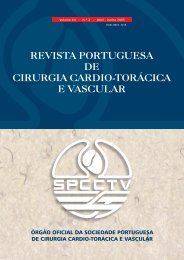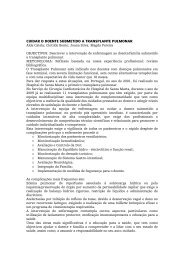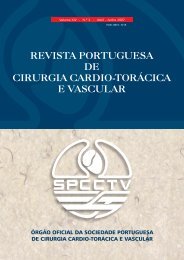Out - Dez - Spcctv.pt
Out - Dez - Spcctv.pt
Out - Dez - Spcctv.pt
Create successful ePaper yourself
Turn your PDF publications into a flip-book with our unique Google optimized e-Paper software.
REVISTA PORTUGUESA DE CIRURGIA CARDIO-TOR áCICA E VASCULARnovamente ao tratamento da endocardite valvular protésica,um mínimo de 6 semanas de terapêutica endovenosa é proposto,seguido na maioria dos casos, por antibioterapia oralpor cerca de 6 meses. Se o material protésico não for substituído,é aconselhada terapêutica supressiva com doxiciclina,trimetoprim-sulfametoxazol ou com uma fluoroquinolonadependendo do perfil de sensibilidade e das caraterísticasdo doente. 15ConclusãoAté à data não existe evidência suficiente que sugiraque o tratamento conservador seja o tratamento de escolhapara os enxertos infetados femoro-distais. A decisão terapêuticadeverá ser baseada na experiência e circunstânciasclínicas particulares de cada caso clínico. Não se deverá, noentanto, ignorar o fato de que na ausência de hemorragiaativa (disrupção anastomótica) ou de sepsis grave, o tratamentolocal agressivo com desbridamento e drenagem decoleções localizadas e o recurso a flaps musculares está associadoa melhores índices de salvação de membro com taxasde reinfeção e mortalidade similares à terapêutica mais convencional.O que parece cada vez mais consensual, sempreque a condição clínica do doente o permita, é o fato de queesta terapêutica conservadora deverá ser sempre consideradacomo um primeiro passo no tratamento do doente com umenxerto infra-inguinal infetado, com uma expetativa bastanterealista de cura e salvação de membro.Os antibióticos utilizados no tratamento da infeçãoprotésica em Cirurgia Vascular deverão ser ativos no biofilme.A minociclina, a da<strong>pt</strong>omicina, e a tigeciclina são significativamentemais eficazes do que a vancomicina e o linezolidecontra o Staphylococcus MRSA presente no biofilme. O linezolidee a tigeciclina são bacteriostáticos contra o MRSA. Ada<strong>pt</strong>omicina apresenta atividade bactericida contra os StaphylococcusMSSA e MRSA. A rifampicina, quando utilizadaisoladamente, está associada ao desenvolvimento de estirpesresistentes. No entanto, a rifampicina poderá ser utilizadacomo um promotor da ação antiestafilococica de outros antibióticos.Quando utilizada em associação com outros antibióticos,rapidamente se consegue a erradicação bacterianaem biofilme.O cruzamento da informação reunida relativamente àprobabilidade de salvação do enxerto de acordo com o grau deinfeção com a informação sobre a microbiologia mais comumpermitirá, no futuro, a adoção de um logaritmo terapêutico noque concerne à infeção protésica vascular periférica. 23BIBLIOGRAFIA1. Szilagyi DE, Smith RF, EUiott JP, Vrandecic MP. Infectionin arterial reconstruction with synthetic grafts. Ann Surg1972;176:321-33.2. Edwards WH Jr, Martin RS III, Jenkins JM, Edwards WH St, MulherinJL Jr. Primary graft infections. J Vasc Surg 1987;6:235-9.3. Johnson JA, Cogbill TH, Strutt PJ, Gundersen AL. Wound complicationsafter infrainguinat bypass. Classification, predisposingfactors, and management. Arch Surg 1988;123:859-62.4. Ehrenfeld WK, Wilbur BG, Olcott CN IV, Stoney RJ. Autogenoustissue reconstruction in the management of infected prostheticgrafts. Surgery 1979;85:82-92.5. Seeger IM, Wheeler JR, Gregory RT, Snyder SO, Gayle RG. Autogenousgraft replacement of infected prosthetic grafts in thefemoral position. Surgery 1983;93:39-45.6. LiekwegWG Jr, GreenfieldLL Vascular prosthetic infections:collected experience and results of treatment. Surgery1977;81:335-42.7. Wilson SE. New alternatives in management of the infectedvascular prosthesis. Surg Infect. 2001;2(2):171–177.8. Williams M, Milling M, Shandall A. Vascularized muscularflaps and arterial graft infection in the groin. Eur J Vasc Surg.2003;25:390–395.9. Mertens RA, et al. Surgical management of infrainguinal arterialprosthetic graft infections: review of a thirty-five-year experience.J Vasc Surg. 1995;21(5):782–791.10. Henke PK, et al. Current o<strong>pt</strong>ions in prosthetic vascular graftinfection. Am Surg. 1998;64(1):39–46.11. Kimmel RM, Murphy RX Jr., Chowdary RP. O<strong>pt</strong>imal managementof inguinal vascular graft infections. Ann Plast Surg.1994;32(6):623–629.12. Meland NB, et al. Muscle-flap coverage for infected peripheralvascular prostheses. Plast Reconstr Surg. 1994;93(5):1005–1011.13. Laustsen J, Bille S, Christensen J. Transposition of the sartoriusmuscle in the treatment of infected vascular grafts in thegroin. Eur J Vasc Surg. 1988;2(2):111–113.14. Cherry KJ Jr, Roland CF, Pairolero PC, Hallet JW et al. Infectedfemorodistal bypass: Is graft removal mandatory? J Vasc Surg1992;15:295-305.15. FitzGerald SF, Kelly C, Humphreys H. Diagnosis and treatmentos prosthetic aortic graft infections: confusion and inconsistencyin the absence of evidence or consensus. J AntimicrobChemother 2005;56(6):996-9.16. Bandyk DF. Vascular surgical site infection: risk factors and preventivemeasures. Semin Vasc Surg 2008;21:119-123.17. Antonios VS, Noel AA, Steckelberg JM, et al. Prosthetic vasculargraft infection: risk factor analysis using a case-controlstudy. J Infect 2006;53:49-55.18. Lorenz U, Schafer T, Ohlsen K, et al. In vivo detection of Staphylococcusaureus in biofilm on vascular prostheses usingnon-invasive biphotonic imaging. Eur J Vasc Endovasc Surg2011;41(1):68-75.19. Wilson SE. New alternatives in management of the infectedvascular prosthesis. Surg Infect 2001;2(2):171-7.20. Samson RH, Veith FJ, Janko GS, Gu<strong>pt</strong>a SK, Scher LA. A modifiedclassification and approach to the management of infectionsinvolving peripheral arterial prosthetic grafts. J Vasc Surg1988;8:147-53.21. Zetrenne E, et al. Managing extracavitary prosthetic vasculargraft infections: a pathway to success. Ann Plast Surg.2006;57(6):677–682.22. Golan JF. Vascular graft infection. Infect Dis Clin N Am1989;3:247-258.23. Leroy O, Meybeck A, Sarraz-Bournet B, d`Elia P, Legout L. Vasculargraft infections. Curr Opin Infect Dis 2012, 25:154-158.24. Edmiston Jr CE, Goheen MP, Seabrook Gr, et al. Impact ofselective antimicrobial agents on staphylococcal adherence tobiomedical devices. Am J Surg 2006;192(3):344-354.25. LaPlante KL, Ryback MJ. Impact of high-inoculum Staphylococcusaureus on the activities of nafcillin, vancomycin, linezolide,and da<strong>pt</strong>omycin, alone and in combination with gentamicin,in an in vitro pharmacodynamic model. Antimicrob AgentsChemother 2004;48(12):4665-72.26. Smith K, Perez A, Ramage G, Gemmell CG, Lang S. Comparisonof biofilm-associated cell survival following in vitro exposureof meticillin-resistent Staphylococcus aureus biofilms tothe antibiotics clindamycin, da<strong>pt</strong>omycin, tigecycline and vancomycin.Int J Antimicrob Agents 2009;33(4):374-378.27. Melo-Cristino J. The ecology of bacterial infection in the hospital.Comunicação oral. Jornadas de Medicina Intensiva daPrimavera – Porto, 19 Abril de 2012.28. Cirioni O, Mocchegiani F, Ghiselli R, et al. Da<strong>pt</strong>omycin andrifampycin alone and in combination prevent vasculr graftbiofilm formation and emergence of antibiotic resistence ina subcutaneous rat pouch modelo f Staphylococcal infection.Eur J Vasc Endovasc Surg 2010; 40:817-822.248 Volume XVIII - N.º 4



